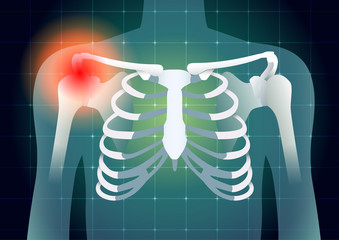You’ve had this niggling pain, which first you could ignore, however it is becoming more and more prominent in your shoulder. You notice it when you reach up high to grab something, when you comb your hair, or when you’re digging in the garden. What could it be, will it go away on its own or should you see a doctor? Check out the guide below of some of the more common shoulder injuries and what to look out for:
Bursitis
 The bursa sacs, small fluid-filled sacs in the joints which help cushion muscles from rubbing against bone, can sometimes become inflamed with overuse or in conjunction with other shoulder injuries like rotator cuff tendinitis. In between the ‘acromion’ part of the shoulder blade and the rotator cuff, sometimes a bursa sac will become inflamed causing painful swelling. This can make it hard to move your arm with even seemingly simple activities like getting dressed.
The bursa sacs, small fluid-filled sacs in the joints which help cushion muscles from rubbing against bone, can sometimes become inflamed with overuse or in conjunction with other shoulder injuries like rotator cuff tendinitis. In between the ‘acromion’ part of the shoulder blade and the rotator cuff, sometimes a bursa sac will become inflamed causing painful swelling. This can make it hard to move your arm with even seemingly simple activities like getting dressed.
Tendinitis
Your shoulder maintains stability in motion through the rotator cuff which is held in place by four tendons that cover the top of your shoulder and keep your arm in its socket. Overtime or with acute injury, these tendons can wear down and provide less stability and cushioning for your arm. Chronic tendinitis may result from degenerative arthritis or simply the overuse of the shoulder throughout a lifetime of physical labour. Acute tendinitis may occur quickly with excessive use of the arm in completing overhead motions, either with day to day work or sport, like throwing a ball, for example.
Arthritis
Osteoarthritis is the most common culprit for arthritis pain of the shoulder, inflicting painful inflammation and stiffness of important joints. Typically beginning around middle age, osteoarthritis symptoms can progress and worsen with age, however, diet, exercise, bracing, and some pharmacological and surgical options can provide relief.
Shoulder Dislocation (Instability)
A sudden injury or prolonged overuse can actually cause the head of the upper arm bone to pop out of the socket either partially or completely. If connective muscles, ligaments, and tendons have previously been strained or torn, your shoulder will be more susceptible to dislocation which also increases your risk of developing arthritis. Even when your shoulder is “relocated,” unsteadiness when raising your arm as well as pain may occur.
Tendon Tears and Impingement
 Different from the wearing down of a tendon like with tendinitis, tendon tears are the physical rupture and tearing of connective tendons in the shoulder due to acute injury, overuse, or degenerative changes in the tendon(s) as you age. Separately, impingement is more of a pinching when the acromion, top of the shoulder blade, presses down on the rotator cuff tendons and bursa when the arm is lifted away from the body. This can also lead to bursitis, tendinitis or a tear in the rotator cuff itself.
Different from the wearing down of a tendon like with tendinitis, tendon tears are the physical rupture and tearing of connective tendons in the shoulder due to acute injury, overuse, or degenerative changes in the tendon(s) as you age. Separately, impingement is more of a pinching when the acromion, top of the shoulder blade, presses down on the rotator cuff tendons and bursa when the arm is lifted away from the body. This can also lead to bursitis, tendinitis or a tear in the rotator cuff itself.
Fracture
Severe pain and swelling after an accident of fall may be from a fracture in important shoulder area bones including the clavicle, upper arm bone, or shoulder blade. Bruising, acute pain, and swelling are signs of a fracture and should be addressed by a medical professional right away.
How might your doctor go about treating your shoulder pain? With proper testing to take a look at the inside of your shoulder (i.e. with x-rays, MRIs, or CTs), a diagnosis may be quite easy, and the good news is that 90% of shoulder pain sufferers find relief with non-invasive treatments. Physical therapy to strengthen muscles and flexibility, bracing with a shoulder brace rotator cuff or temporary sling, changes in activity level to prioritise beneficial exercise, and rest are typically the order of the day, though injections or surgery may be discussed as well. If your shoulder pain is trying to tell you something, listen up! Taking steps now can prevent a rapid progression of symptoms and give you more relief (and freedom to do what you want) in the long run.









Join the Discussion
Type out your comment here:
You must be logged in to post a comment.